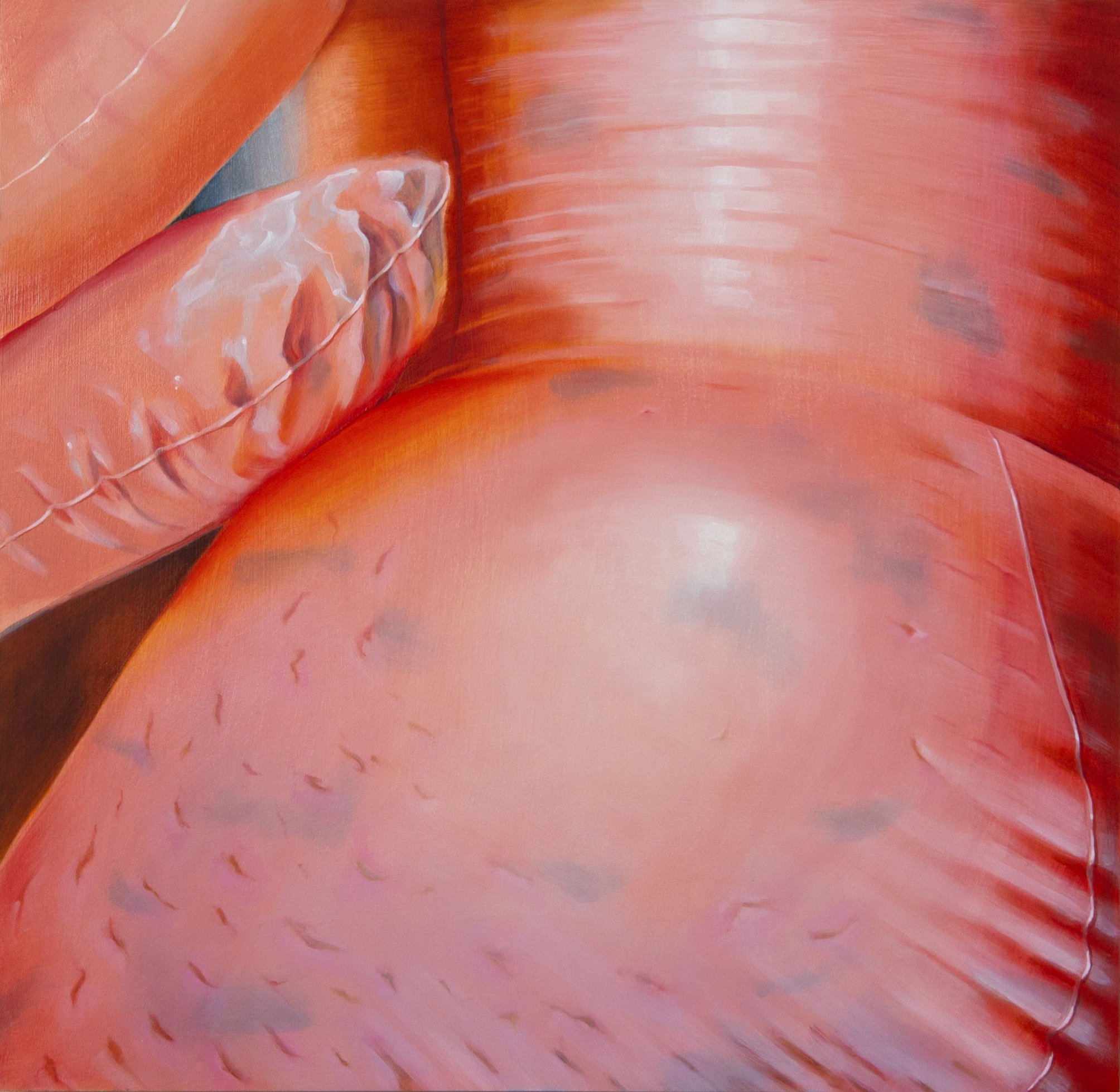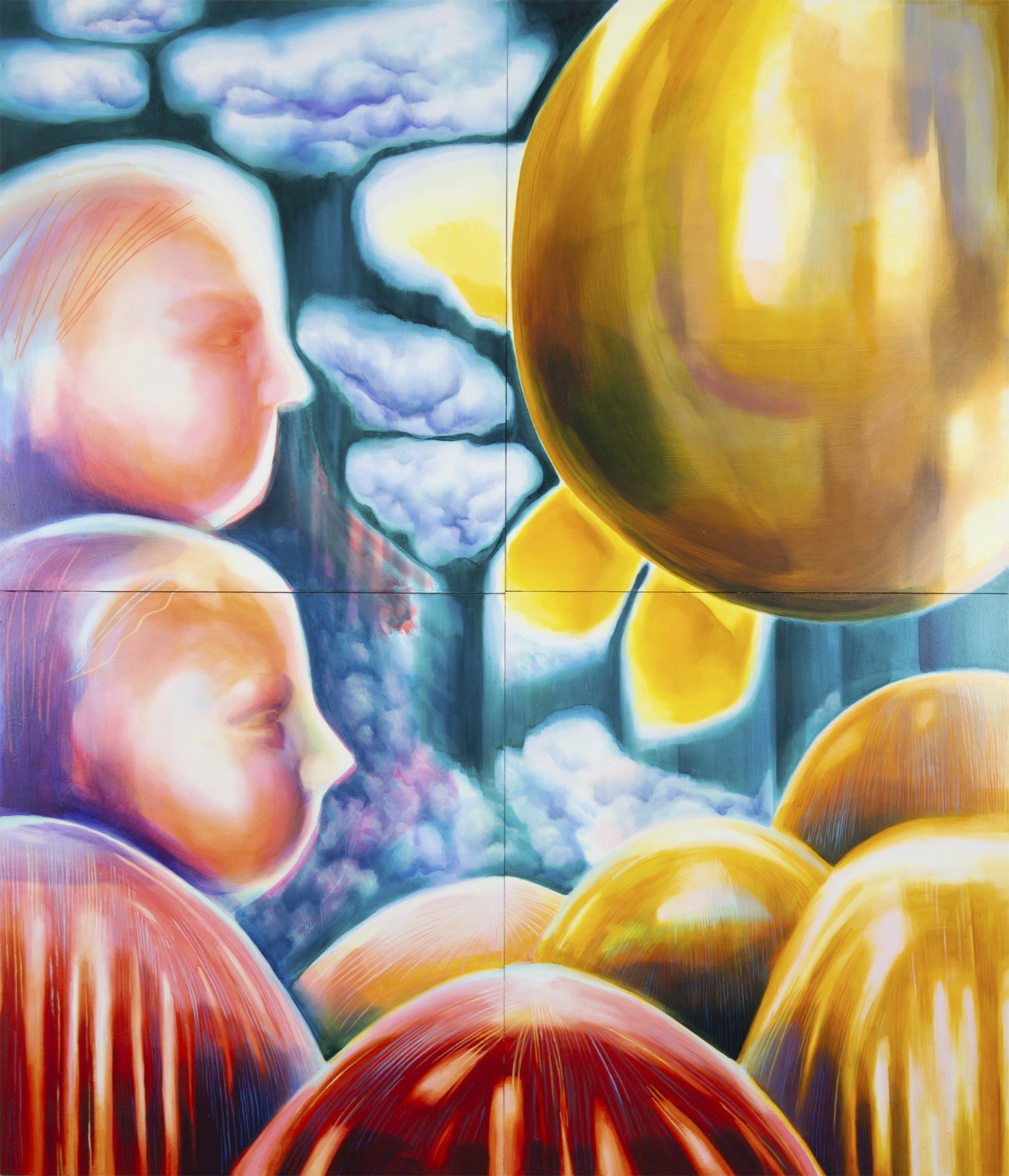Ema Pina
In an era inundated with visual stimuli from screens in advertising, film, and social media, Portuguese artist Ema Pina's work delves into the materiality of oil painting in today's digital age. She thoughtfully explores the interconnectedness between the presence of objects and the essence of human existence. Within her artistic realm, recurring motifs of inanimate items like dolls and chair legs merge with organic elements, such as clouds and sunflowers, adopting a human quality that blurs the lines between subject and object. Her compositions, built up through layers of glazes and opacities, coupled with her distinctive use of colour and tone, contribute to a unique dreamscape aesthetic within her art.
Ema Pina, 2023. Photo Courtesy: Ema Pina.
Born in Porto, of Portuguese and Guinea Bissau heritage, Ema began her artistic journey in childhood, but the pivotal decision to fully embrace art unfolded in her early twenties. Fondly reminiscing about her upbringing in an old three-storey house in the centre of Porto, she cherishes memories of running up and down stairs with cousins and friends, alongside days immersed in drawing. Despite early encouragement, the perceived limited prospects of a fine art career led her to study Economics instead.
While studying Economics, Ema actively sought international contemporary art publications to enrich her artistic understanding. After two years working in audits, she bravely reset her life to pursue art at Central Saint Martins in London. Through a foundation course which led to a BA in Fine Art, Ema explored her interests, surroundings, and life through the lens of art. In London, she found a supportive community, securing a painting scholarship for her final degree show. Graduating in 2014, Ema established her studio in south London, allowing her the freedom to connect diverse ideas, utilise imagination, and engage in continuous learning through the creation of art.
Ema Pina, Booming II, 2023, oil on wooden board, 100 x 80cm. Photo Courtesy: Ema Pina.
Ema primarily works from drawings, photographs of carefully arranged props in small settings, and observations, whether direct or recalled. She maintains a growing digital and physical archive of intriguing snapshots from her surroundings. These images serve as source material that she reworks through drawing, manipulating shapes, colours, textures, and scale. The paintings gradually evolve from wooden panels, building up through multiple layers of glazes and opacities, creating tonal equilibrium and psychological depth. Surface texture holds particular significance for Ema, and she negotiates various ways of representing different surfaces through the application of paint. As her artistic practice evolves, discoveries made in the creation of previous paintings become the catalysts for new works. This iterative approach allows her to continually explore and expand upon the possibilities within her art.
Ema Pina, Sway, 2023, oil on wooden board, 72 x 63 cm. Photo Courtesy: Ema Pina.
The initial palette of Ema's work was dominated by browns and earthy colours, with paintings emerging from flesh-toned panels of wood. Over time, her palette has now expanded to include vibrant, technicolour hues. She conceptualises colour relations in terms of light, emotional charge, and the symbiosis between organicity and artificiality.
In addition to her archive of images and observations, Ema taps into a rich array of artistic and literary resources for inspiration. The poetry of Portuguese authors Fernando Pessoa and Herberto Halder serves as a constant well of reflection for her. Cinematography, including the works of Tarkovsky and the docufiction films of Pedro Costa, has also opened possibilities. Indeed, screen imagery itself—light-emitting images, cinema, or pocket size—serves as a source of reference.
Ema consistently returns to the works of three influential artists: Manet, Rothko, and Morandi. Her reasons for returning to each artist can act as a key to unlocking the ideas and intentions behind Ema’s work. She is drawn to the work of Manet for its depictions of introspection, noting how his figures, despite inhabiting the modern world, exist in their own contemplative realms. Rothko, for the sensations his colours evoke, creating a profound emotional impact. And Morandi for his arrangements of little jars, vases and mugs, which all seem to have a human presence, competing for space. She recalls a review describing Morandi's work, noting that "The very conditions of existence are the subjects of his paintings.", a sentiment that deeply resonates with her own artistic endeavours.
Ema's artistic exploration is intimately connected to the notion of objects coming into being. In her own words, she experiences moments where she feels confronted by the sheer presence of a chair, as if it is gazing back at her—an intangible, undeniable presence. Such sentiments find vivid expression in her work Sway, where chair legs transform into the semblance of ballerina pumps, the overhanging lace tablecloth mimics a tutu, and the ground mirrors a mirage-like landscape of trees. Through such creations, Ema captures the essence of these everyday objects, endowing them with a captivating and enigmatic presence.
Ema Pina, Fishing Flamingos, 2023, oil on wooden board, 100 x 110cm. Photo Courtesy: Ema Pina.
Following graduation, the elusive presence of flamingos emerged in Ema's paintings. She affectionately describes these exotic and uncommon birds as “The pink birds of dreams.” Fishing Flamingos, originated as a drawing and evolved into a painting, depicting flamingos as reflections on water. The title, Fishing Flamingos, cleverly toys with the notion of attempting to fish a flying flamingo represented as a reflection—an unattainable endeavour. The reflected image metamorphoses into a mirage, reminiscent of glitches in film. Ema intentionally incorporates these visual anomalies, exploring the intricate interplay between perception and representation. Moreover, she describes the artwork as a metaphor for the processes of reflexivity and interiority within the human mind. Within this reflective space, the giant sunflower motif from previous paintings also manifesting. This inclusion envelops the viewer into Ema's distinctive artistic universe, offering a glimpse into the captivating and introspective world she skilfully constructs.
Ema Pina, Medusa, 2023, oil on wooden board, 52 x 51 cm. Photo Courtesy: Ema Pina.
Consistently attuned to the material properties of her environment, Ema keenly observes the appearance of objects and bodies, contemplating the emotions they evoke. This exploration extends to various settings, from being out and about to moments at home or during train rides. Even the subtlest details, like a surface lighting effect, catch her attention, becoming potential inspirations for future paintings. Take Medusa, for instance. Ema was inspired by the play of light on her wine glass, creating a fantastical refraction on a lace tablecloth. The title Medusa carries a double meaning, referencing both the jellyfish and the ancient Greek myth of a woman with venomous snakes for hair. This painting became a reflection on illusions, constructions of illusory spaces, and a connection of moments, with the circular shape hinting at interpretations like an eye or a breast when viewed out of context.
Ema Pina, Rhizome, 2023, oil on wooden board, 63 x 51 cm. Photo Courtesy: Ema Pina.
Another piece, Rhizome, originated from photographs of desk lamps and cityscapes, connecting in Ema's mind like a network, akin to plant roots. The refraction of lights can be interpreted as fireworks, with the lamp shape resembling sperm and symbolising the connection of all life. Ema describes, it is when “all these connections click into place” that she finally feels she can work on them in her painting.
Ema Pina, Touchy, 2023, oil on wooden board, 51 x 52 cm. Photo Courtesy: Ema Pina.
There is a sensuality underpinning much of Ema’s work. In Touchy, she engages with a blow-up plastic doll, an object she has explored since her time at Central Saint Martins. The artificiality of the plastic human form and the challenge to render it natural and organic drive her artistic process. Inspired by the wrinkles she found when taking the plastic blow-up doll out of storage, Ema contemplated the wrinkles on our own bodies. How could she paint it to make it more human-like? By incorporating elements like bruising to the skin, cellulite, and another doll hand touching the hip. The cellulite could also allude to the flamingos in previous paintings, mirroring a flock of cellulite. She employs cinematic tools such as zooming in, allowing intentional cropping and manipulation of the body to occur.
Ema Pina, Akin, 2023, oil on wooden board, 118 x 102 cm (4 boards, 59 x 51 cm each) Photo Courtesy: Ema Pina.
In Akin, Ema delves into the realm of helium balloons, and floating heads, akin to molecules. These elements can embody a crowd or an audience, representing the individual parts of a whole ascending. Painted during the pandemic, albeit unconsciously, the piece reflects the prevalent imagery of virus patterns and molecules at a time when discussions about togetherness and our connection to everything and everyone were paramount. Clouds emerge as a new symbol in Ema’s recent work. Observing the rapidly changing colours of clouds outside her window, she envisioned the sky as bruised with clouds. In her words, "If the sky was a body, the grey clouds would be the bruises of the sky."
Ema Pina, Cloudy, 2023, oil on wooden board, 72 x 60 cm. Photo Courtesy: Ema Pina.
Ema Pina, Fronting, 2023, oil on wooden board, 122 x 93 cm. Photo Courtesy: Ema Pina
Currently, Ema is holding a solo show, 'Aerosols,' at Caldeiraria gallery in Porto's historic centre. The exhibition presents recent paintings and drawings which explore the interplay between objects and nature, conceptualising them as integral components of a broader system. This system, much like the surrounding atmosphere, is often sensed but remains unseen. Among the showcased pieces are Fronting and Touchy.
Ema's meticulous painting process beckons extended observation, gradually revealing intricate details that draw viewers deeper into her world. The longer one engages, the more nuance one can uncover. Spend time, and you'll notice sunflower eyes or flamingos by the water's edge—glimpses into Ema's unique perspective. To see the world through her eyes is to step into a realm of vibrant colours and endless possibilities, offering a transformative experience for those who engage with her work. And as you leave, cast your gaze upward at the sky; amongst the flamboyant clouds, you might catch sight of a little bruise on the horizon.
Ema Pina’s Solo show ‘Aerosols,’ at Caldeiraria Gallery, Porto is on until 19th of February 2024. To learn more about Ema Pina, follow her on Instagram or visit her website.
Selected Exhibitions:
2024 Aerosols, Caldeiraria, Porto, PT (solo)
2023 Common Denominators, Hotel Flor de Sal, Viana do Castelo, PT (solo)
2023 New Wave, Spitalfields Studios, London, UK
2023 Do You Buy This?, Ugly Duck, London, UK
2019 Void Feelers, Thames-Side Viewing Room, London, UK
2018 Here then, was I / Here now, am I, Thames-Side Studios Gallery, London, UK
2016 Through a Screen Darkly, Gallery Sensei, London, UK
2016 The Future is Female, La Porte Peinte, Noyers, FR
2015 Lynn Painter-Stainers Prize, Mall Galleries, London, UK
2014 Clyde & Co Art Award Collection 2014-15, Clyde & Co, London, UK
2013 TombRaiders, Petrie Museum, London, UK
Awards
2020 Editorial Mentorship, Hedera Felix ︎
2019 The Eaton Fund, Eaton Fund
2015 The Brian Botting Prize, The Worshipful Company of Painter-Stainers
2014 Kate Barton Award, Central Saint Martins
2014 The Clyde & Co Art Award Collection 2014-15, Clyde & Co
Collections
University of the Arts London
The Worshipful Company of Painter-Stainers
La Porte Peinte Centre pour les Arts
Annette Fernando
Emerging Artist Co-Editor, MADE IN BED











